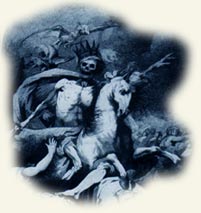But calculated dates were not the only fuel for the belief of an imminent end of the world. 'And he spake to them a parable; Behold the fig tree, and all the trees; When they now shoot forth, ye see and know of your own selves that
summer is now
nigh at hand. So likewise ye, when ye see these things come to pass, know
ye that the kingdom of God is nigh at hand.'![]()
Signs are not only given in the Gospels, but also in many other places, such as the Revelation of John. Others only developed at a later stage, like the Last World Emperor, an idea that also had political effects, such as the traduction of the Roman Empire. Proof of the reaction to possible signs can still be found. In 968, for example, 'Soldiers in Otto's army panic at an eclipse, which they see as a sign of the end', while the apparition

of Halley's
comet in 989 'is seen by many as yet another sign of the coming apocalypse',
just as the great famine throughout Europe in 1005-06.![]()
These signs could be interpreted individually by single persons as well as larger groups and were not dependent on fixed dates. They thus enabled a continuous flow of apocalypticism throughout the centuries.
| The Thief in the Night | Signs of Doom | Anglo-Saxon Expectations |